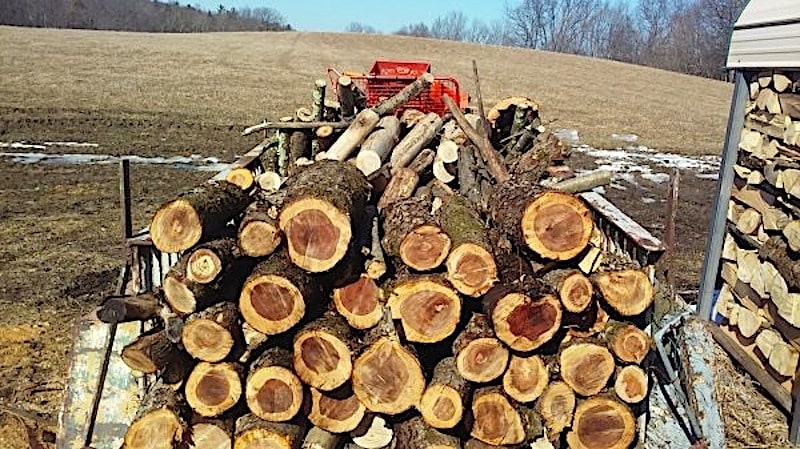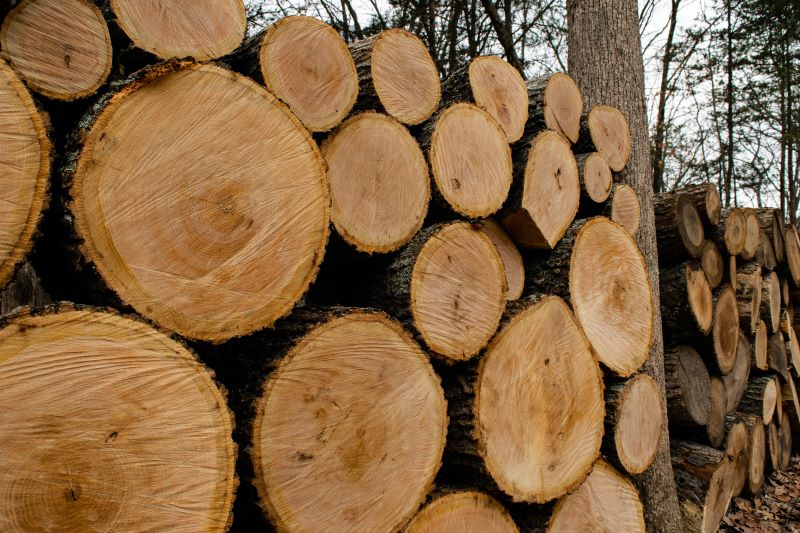Thanks for your support! If you make a purchase using our links in this article, we may make a commission. And, as an Amazon Associate, I earn from qualifying purchases. See the full disclosure here.
No, we’re not talking about why you should avoid moving firewood from your seasoned oak stack to your outdoor fire pit. No, this topic is a little more in-depth than most people realize.
In fact, it gets into legal repercussions if you’re not careful, depending on what state you’re standing in. And in most states, moving firewood is illegal.
Everybody loves a good fire. As expanding steam reaches maximum pressure and bursts, you get that satisfying snap, crackle, and pop throughout a leisurely evening under the stars.
It’s worth the labor of setting up, especially if you have kids with marshmallows and long sticks.
The term ‘moving firewood’ refers to the complication and potential illegality of hauling it with you. Some states are fairly strict about it, making the campgrounds even stricter to stay within the boundaries of state law.
We’ll dive into the nitty-gritty of moving firewood and, hopefully, keep you legal when you park at your next camping destination.
Are You Allowed to Move Firewood?
Most states allow residents to move firewood and most have restrictions on that movement. Depending on which state you live in, you typically face one of two restrictions.
The first is a restriction from moving wood across state lines. The second is a restriction from moving wood more than a set number of miles from its source.
Almost every state has a set rule or regulation regarding the movement of wood from one place to the other. The burden is on you to look up your state, county, or city regulations.
If you live close to another state, that’s just another reason why you should avoid moving firewood. Regardless of your state’s rules, they no longer apply when you cross into another state.
The moment your front bumper crosses into another state, you fall under that state’s rules and regulations on the movement of firewood.
None of this means you can’t purchase firewood from a local seller, load it up in a 1/2-ton, and haul it to the house. If that seller is over 50 (some states are less restrictive on distance) miles away, however, it’s a good idea to check your state laws before you go get it.
Are you likely to get pulled over on your way home? No, not as long as you’re obeying traffic laws. But, you never know.
A simple speeding ticket may morph into something much bigger if you’re transporting that wood across state lines or over 50 miles.
Why is Moving Firewood a Bad Idea?

Why you should avoid moving firewood isn’t just about the legality of it, though that’s a big part. There’s also an ecological cost that most people don’t think about or concern themselves with. Not out of spite, just out of not knowing any better.
For instance, insects in Florida are perfectly fine where they are. However, if you transfer them (accidentally) to some farmland in Tennessee, and the reproducing insects hammer some poor farmer’s crops, that’s on you.
It’s also why the laws exist in the first place (or, at least, a major part of it). Disease is another part. Crops are just as vulnerable to specific diseases as they are to insects.
It’s not just crops you have to worry about either. It’s the ecology as a whole. Florida is a good example. Right now, the state is engaged in a fierce culling of Burmese pythons in the Everglades.
These Burmese pythons are not native to the state and they are wreaking havoc on the natural species that live there. The state is paying residents to hunt these things down, some of which grow up to 30′ in length.
When you ask yourself, “Why you should avoid moving firewood,” the Burmese pythons in Florida are a fine example. Introducing any new species to an environment can come with major repercussions.
Are There Fines for Moving Firewood?
Yes, there are fines for moving firewood. Some states are so restrictive about it that you can get a fine for moving firewood from one county to another county within the same state. We could probably write a novel if we covered the fine print in every state.
Of course, that’s why it’s imperative that you know the law in your state, all the way down to local regulations. While it’s a state-by-state issue, most states are dead serious about punishment for moving firewood.
Again, at the risk of beating a dead horse, we point to the Burmese pythons in Florida. Since the invasive species was introduced to the area, the raccoon population dropped by 99.3% and bobcats by 87%. Foxes and certain species of rabbits are completely gone.
All of that was because people were ambivalent about their pet snakes. That’s why states take these things so seriously.
It’s well known that the transportation of wood from one place to the other runs the risk of also transporting disease and invasive species. Those two alone are capable of costing states millions, if not billions of dollars in damages.
Another good example is the Emerald Ash Borer in the state of Illinois. They’re wreaking havoc on Illinois’ ash trees and they are a species not native to North America. They were transported there somehow, however, and Illinois is paying the price.
The Animal and Plant Health Inspection Service, within the US Department of Agriculture, oversees the movement of firewood. When anything crosses state lines, it often becomes subject to federal purview via federal regulation of interstate commerce.
Of course, local authorities will enforce state laws if you’re caught, with fines and punishment according to state law.
How Far Can You Move Firewood Between Locations?

Not knowing the specifics of local, county, state, and federal laws is why you should avoid moving firewood. If you’re willing to take the risk, you need to check your local guidelines and state laws.
There is a website that has all fifty states listed, along with their rules and regulations on transporting firewood. It’s called “Don’t Move Firewood” and it’s a nifty site to keep bookmarked on your smartphone or PC.
There are a handful of states that are very strict about firewood transportation and the following is a list of those states:
- Indiana
- Illinois
- Kentucky
- Maryland
- Michigan
- Minnesota
- Ohio
- Wisconsin
Another good resource to check with is the National Park Service, which also has a link to the Don’t Move Firewood site.
Are There Any Types of Firewood You Can Transport?
USDA-certified firewood products are typically better for transporting without creating too much of an outcry. It’s not enough to exempt you from double-checking your state laws and any state you want to travel to.
Heat-treated wood is also considered safer. However, just like USDA-certified firewood, check and check again before you load up and start hauling.
In fact, kiln-dried wood is not on the same level as USDA-certified wood and still falls under the rules and regulations for crossing state lines.
Can I Use Firewood I Cut From My Own Property?

That depends on what you mean by “using” it. You can dance around the fire like Tom Hanks in Cast Away, on your own property until your heart is content.
So long as you aren’t violating any burn permits in your county. As far as transporting it, you’re still subject to the same laws.
When most states mention distance limitations from the “source,” that includes your home. If your state has a law against transporting firewood more than 50 miles from the source of the wood, your house merely serves as the source, in this instance.
5 FAQs on Moving Firewood
1. Are you allowed to move firewood?
You are allowed to move firewood within the boundaries of your state, county, and city rules and regulations. Anything outside of that is subject to a fine, most of which exceed $200.
2. How far can you move firewood?
How far you can move it also depends on your state. Some states have a very short mileage while others will let you carry firewood for hundreds of miles within the state. If you’re unsure, check your state on the Don’t Move Firewood site just to be sure.
3. Are there fines for moving firewood?
Most states have fines if you’re caught moving firewood outside the boundaries of that state’s laws on the matter. Some of those fines are relatively minor. However, in some states, where firewood transportation has caused a lot of grief, those fines are much higher.
4. Can I cut and use my own firewood?
You’re more than welcome to cut and use your own firewood so long as you don’t transport it outside of the distance limitation in your state. If you cut it and burn it in your own yard, you’re only subject to local ordinances, such as burn permits.
5. Why can Home Depot and Walmart sell firewood if it can’t be moved?
Firewood sold by Walmart and Home Depot is regulated (throughout the transportation process) by the US Department of Agriculture. It will only be wood that is certified by the USDA.
There might be local sellers that sell firewood on Walmart or Home Depot property, but that is only for local purposes, within the boundaries of state law.
Final Thoughts On Why You Should Avoid Moving Firewood
While not being able to transport wood long distances might be personally irritating, there are too many solid reasons for regulating it.
The transportation of firewood could also mean the transportation of diseases, insects, and other organisms that may decimate the local ecologies they arrive in.
Illinois and Florida are prime examples of why the transportation and purchase of certain products must be regulated. In Illinois, it’s ash borers. In Florida, it’s Burmese pythons.
Next time, it could be a major blow to the agricultural industry in the Rust Belt, California, or the Great Plains. Such a devastating impact would eventually touch every home in America.
Related Reading:
1. 12 Best Smelling Firewoods (Campfires or Fireplaces)
2. Bonfire vs Campfire: Differences Explained
3. How to Get Campfire Smell Out of Clothes and Hair
4. 16 Best RV Campsite Setup And Decorating Ideas
Thomas Godwin – Author and Part-Time RVer
Thomas Godwin is a full-time freelance writer with a BFA in Creative Writing, a U.S. Marine, and an avid outdoorsman.
Thomas’s love for RVing began at an early age spending time camping in the family vintage Airstream.
His background and education in writing, combined with his passion for the outdoors, can be seen in publications such as Camper Smarts and Vanlifers, as well as multiple animal and outdoor recreational publications.
When he’s not writing, he’s raising chickens and Appleyard ducks. Thomas also constructs teardrop campers (attempting to anyway) and kayaks the Blackwater River with his wife, two daughters, and his Dobermans.


